DS博客作业02--栈和队列
| 这个作业属于哪个班级 | 数据结构--网络2011/2012 |
|---|---|
| 这个作业的地址 | DS博客作业02--栈和队列 |
| 这个作业的目标 | 学习栈和队列的结构设计及运算操作 |
| 姓名 | 王历 |
0 PTA得分截图

1.本周学习总结(0-5分)
1.1 栈
画一个栈的图形,介绍如下内容。

- 顺序栈的结构、操作函数

** 1)初始化栈initStack(&s)**
void InitStack(SqStack * &s)
{
s = (SqStack * )malloc(sizeof(SqStack));
s->top = -1;
}
2)销毁栈DestroyStack(&s)
void DestroyStack(SqStack * &s)
{
free(s);
}
3)判断栈是否为空StackEmpty(s)
bool StackEmpty(SqStack *s)
{
return(s->top == -1);
}
4)进栈Push(&s,e)
bool Push(SqStack * &s,Elemtype e)
{
if(s->top == MaxSize - 1)
return false;
s->top++;
s->data[s->top] = e;
return true;
}
5)出栈Pop(&s,&e)
bool Pop(SqStack *&s,Elemtype &e)
{
if(s-> top ==-1)
return false;
e = s->data[s->top];
s->top--;
return true;
}
6)取栈顶元素GetTop(d, &e)
bool GetTop(SqStack *s,Elemtype &e)
{
if(s->top == -1)
return false;
e = s->data[s->top];
return true;
}
- 链栈的结构、操作函数
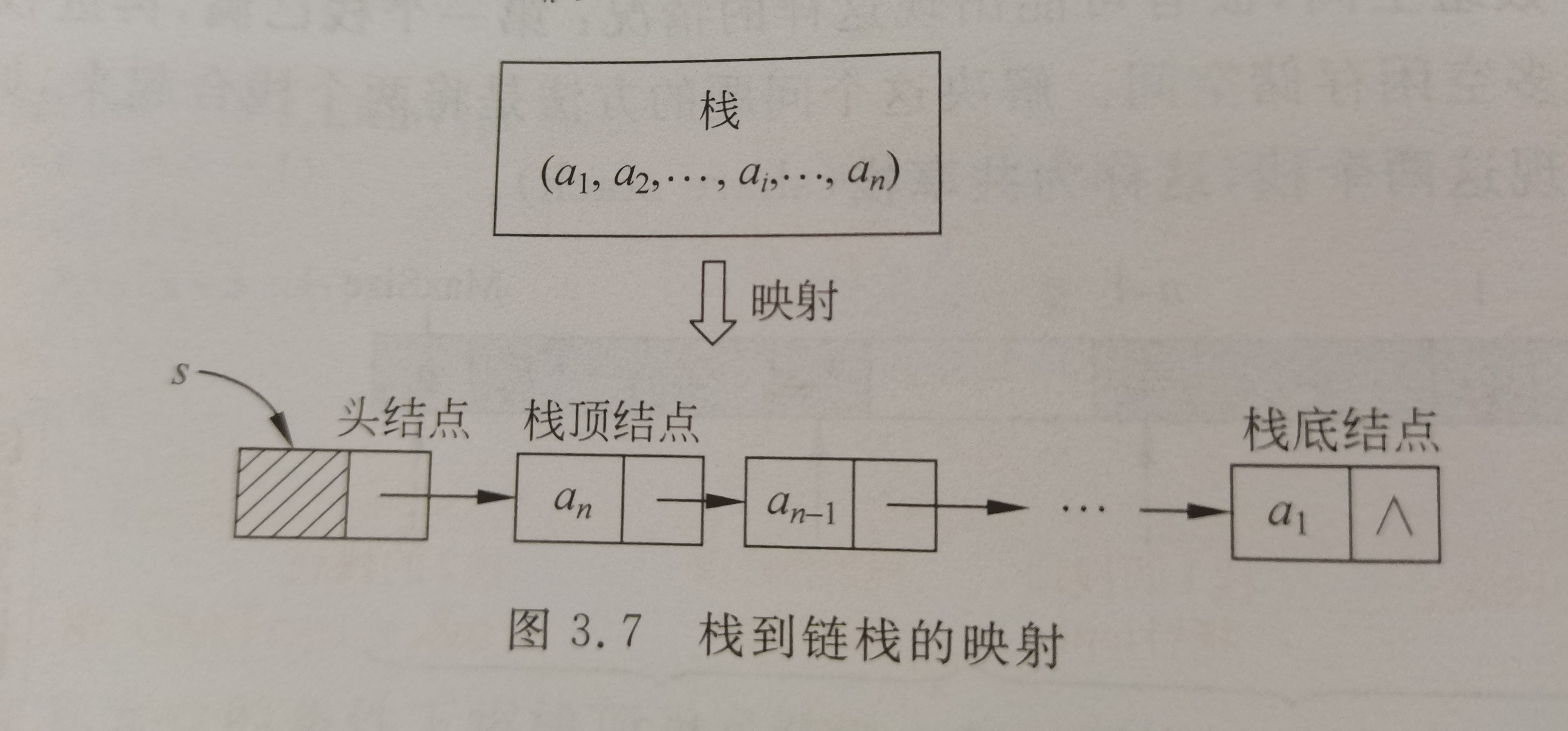
1)初始化栈initStack(&s)
void InitStack(LinkStNide * &s)
{
s = (LinkStNide *)malloc(sizeof(LinkStNide ));
s->next = NULL;
}
2)销毁栈DestroyStack(&s)
void DestroyStack(SqStack * &s)
{
LinkStNode * pre = s, *p = s->next;
while(p != NULL)
{
free(pre);
pre = p;
p = pre->next;
}
free(pre);
}
3)判断栈是否为空StackEmpty(s)
bool StackEmpty(SqStack *s)
{
return(s->next == NULL);
}
4)进栈Push(&s,e)
bool Push(SqStack * &s,Elemtype e)
{
LinkStNode *p;
p = (LinkStNode *)malloc(sizeof(LinkStNode ));
p->data = e;
p->next = s->next;
s->next = p;
}
5)出栈Pop(&s,&e)
bool Pop(SqStack *&s,Elemtype &e)
{
LinkkStNode *p;
if(s->next == NULL)
return false;
p = s->next;
e = p->data;
s->next = p->next;
free(p);
return true;
}
6)取栈顶元素GetTop(d, &e)
bool GetTop(SqStack *s,Elemtype &e)
{
if((s->next == NULL)
return false;
e = s->next->data;
return true;
}
1.2 栈的应用
- 表达式
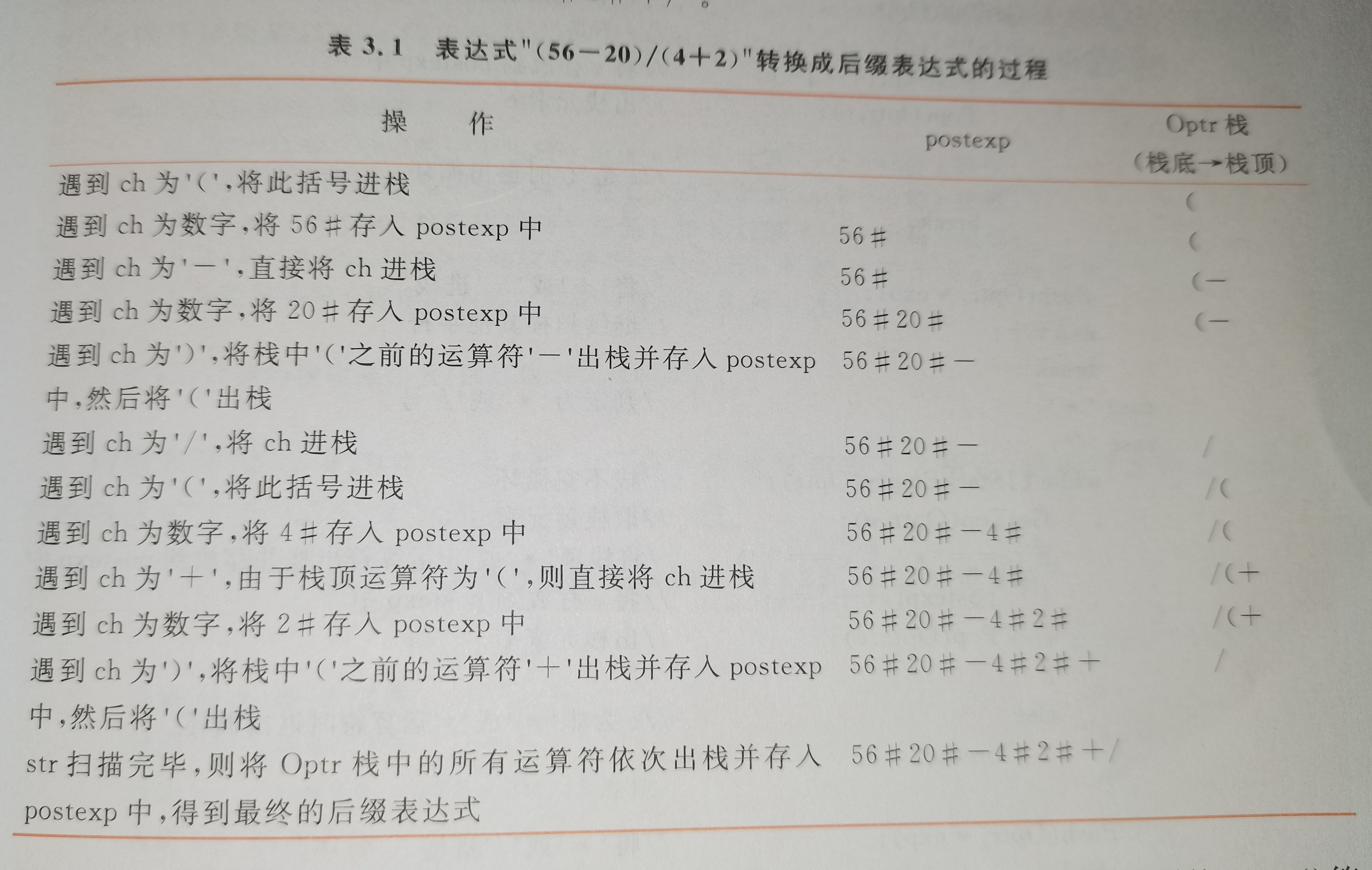
伪代码
while(从exp读取字符ch,ch!='\0')
{
ch为数字:将后续的所有数字均依次存放到postexp中,并以字符'#'标识数字串结束;
ch为左括号'(':将此括号进栈到Optr中;
ch为右括号')':将Optr中出栈时遇到的第一个左括号'('以前的运算符依次出栈并存放到postexp中,然后将左括号'('出栈;
ch为'+'或'-':出栈运算符并存放到postexp中,直到栈空或者栈顶为'(',然后将ch进栈;
ch为'*'或'/':出栈运算符并存放到postexp中,直到栈空或者栈顶为'('、'+'或'-',然后将ch进栈;
}
若exp扫描完毕,则将Optr中的所有运算符依次出栈并存放到postexp中。
**设置运算符栈类型SqStack中的ElemType为char类型。根据上述原理得到的trans()算法如下:
void trans(char *exp,char postexp[])
{
char e;
SqStack *Optr;
InitStack(Optr);
int i = 0;
while(*exp != '\0')
{
switch(*exp)
{
case'(':
Push(Optr,'(');
exp++;
break;
case ')':
Pop(Optr,e);
while(e != '(')
{
postexp[i++] = e;
Pop(Optr,e);
}
exp++;
break;
case'+':
case'-':
while(!StackEmpty(Optr))
{
GetTop(Optr,e);
if(e != '(')
{
postexp[i++] = e;
Pop(Optr,e);
}
else
break;
}
Push(Optr,*exp);
exp++;
break;
case'*':
case'/':
while(!StackEmpty(Optr))
{
GetTop(Optr,e);
if(e == '*' || e == '/')
{
postexp[i++] = e;
Pop(Optr,e);
}
else
break;
}
Push(Optr,*exp);
exp++;
break;
default:
while(*exp >= '0' && *exp <= 9)
{
postexp[i++] = *exp;
exp++;
}
postexp[i++] = '#';
}
while(!StackEmpty(Optr))
{
Pop(Optr,e);
postexp[i++] = e;
}
postexp[i] = '\0';
DestroyStack(Optr);
}
1.3 队列
画一个队列的图形,介绍如下内容。
- 顺序队列的结构、操作函数

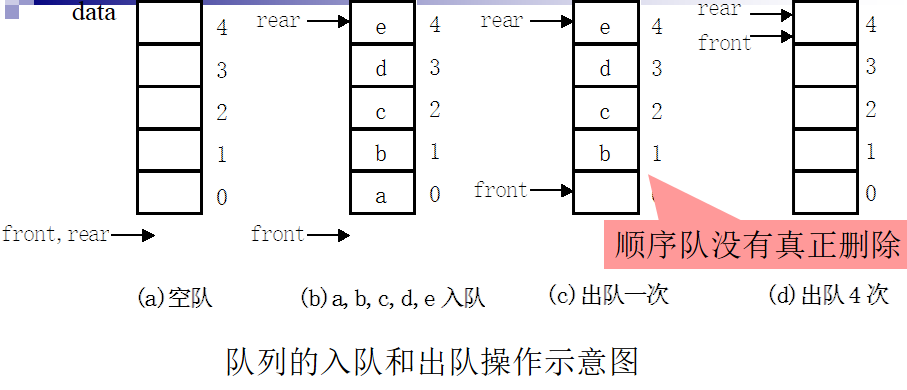
1)初始化队列InitQueue(q)
void InitQueue(SqQueue &q)
{
q = new Queue;
q -> front = q -> rear = -1;
}
2)销毁队列DestroyQueue(q)
void DestroyQueue(SqQueue &q)
{
delete q;
}
3)判断队列是否为空QueueEmpty(q)
bool QueueEmpty(SqQueue q)
{
return(q ->front == q->rear);
}
4)进队列enQueue(q,e)
bool enQueue(SqQueue &q,ElemType e)
{
if(q->rear+1 == MaxSize)
return false;
q->rear = q->rear + 1;
q->data[q->rear] = e;
return true;
}
5)出队列deQueue(q,e)
bool deQueue(SqQueue &q,Elempty &e)
{
if(q->front == q->rear)
return false;
q->front = q->front + 1;
e = q->data[q->front];
return true;
}
- 环形队列的结构、操作函数
 *
*
1)初始化队列InitQueue(q)
void InitQueue(SqQueue &q)
{
q = new Queue;
q -> front = q -> rear = 0;
}
2)销毁队列DestroyQueue(q)
void DestroyQueue(SqQueue &q)
{
delete q;
}
3)判断队列是否为空QueueEmpty(q)
bool QueueEmpty(SqQueue q)
{
return(q ->front == q->rear);
}
4)进队列enQueue(q,e)
bool enQueue(SqQueue &q,ElemType e)
{
if(q->rear+1 % MaxSize == q->front)
return false;
q->rear = (q->rear + 1) % MaxSize;
q->data[q->rear] = e;
return true;
}
5)出队列deQueue(q,e)
bool deQueue(SqQueue &q,Elempty &e)
{
if(q->front == q->rear)
return false;
e = q->data[q->front];
q->front = (q->front + 1) % MaxSize;
return true;
}
- 链队列的结构、操作函数
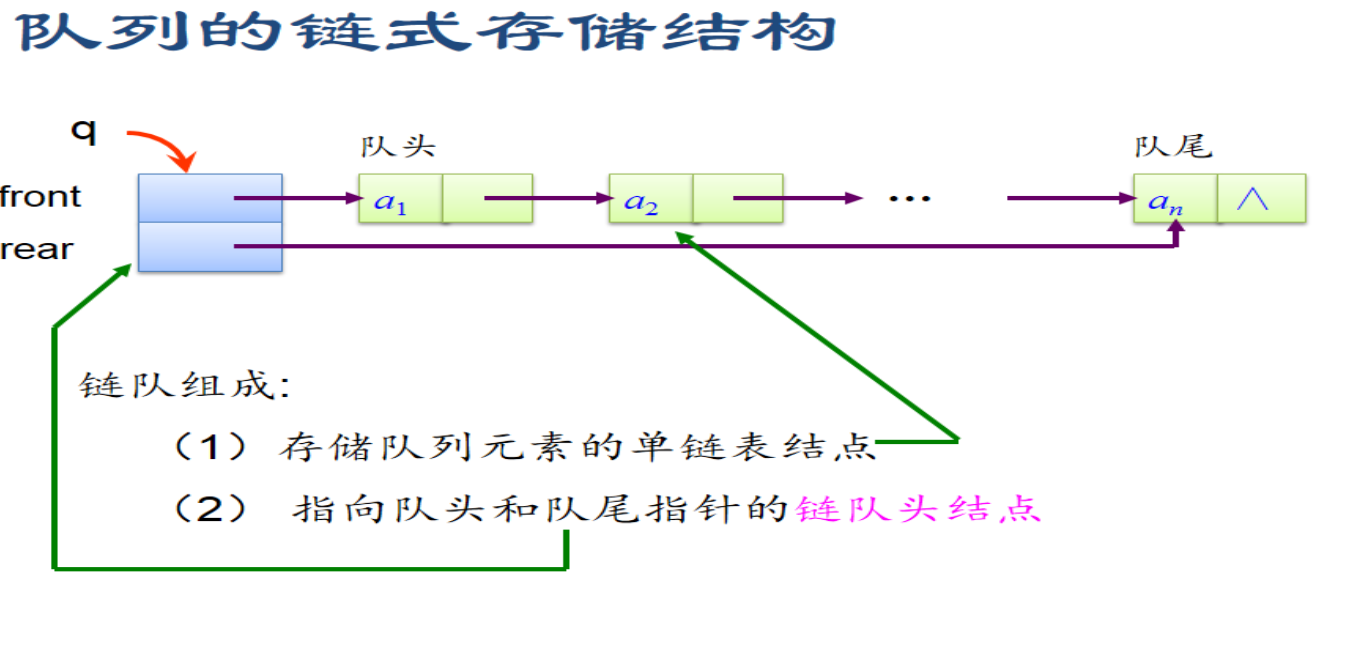
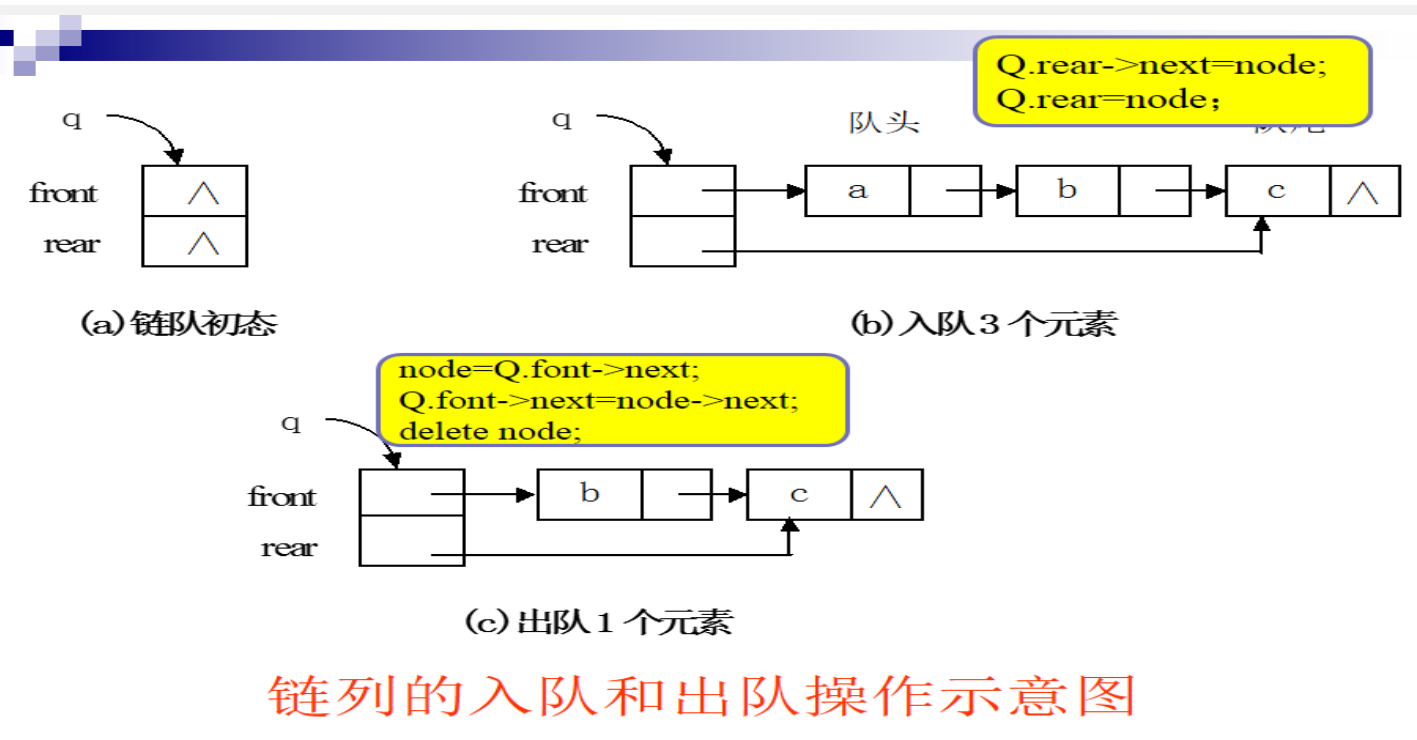
1)链队列初始化
Status InitQueue(LinkQueue &Q)
{
Q.front = Q.rear = new QNode;
if(!Q.front)
exit(OVERFLOW);
Q.front->next = NULL;
return OK;
}
2)判断链队列是否为空
Status QueueEmpty(LinkQueue Q)
{
return(Q.front = Q.rear);
}
3)求链队列的队头元素
Staus GetHead(LinkQueue Q,QElmType &e)
{
if(Q,front == Q,rear)
return ERROR;
e = Q.front->next->data;
return OK;
}
4)链队列入队
Staus EnQueue(LinkQueue &Q,QElemType e)
{
p = new QNode;
if(!p)
exit(OVERFLOW);
p->data = e;
p->next = NULL;
Q,rear->next = p;
Q.rear = p;
return OK;
}
5)链队出队
Staus DeQueue(LinkQueue &Q,QElemType &e)
{
if(Q.front == Q.rear)
return ERROR;
p = Q.front->next;
e = p->data;
Q.front->next = p->next;
if(Q.rear == p)
Q.rear = Q.front;
delete p;
return OK;
}
- 队列应用,要有具体代码操作。
2.PTA实验作业(4分)
2.1 符号配对
2.1.1 解题思路及伪代码
#include <iostream>
#include <stack>
#include <string>
using namespace std;
stack<char> stk;
char tmp[] = { ')','}',']' };
void output(char ch)
{
if (ch == '<')
{
cout << "NO\n/*-?" << endl;
}
else
{
cout << "NO\n" << ch << "-?" << endl;
}
}
bool match(char* c, int len)
{
int i = -1;
int j = 0;
while (++i < len)
{
if (c[i] == '/')
{
if (stk.empty()) if (c[i + 1] != '*')
continue;
if (c[i + 1] == '*')
{
stk.push('<');
++i;
}
else if (stk.top() == '<' && c[i + 1] != '*')
{
cout << "NO\n/*-?" << endl;
return 0;
}
}
else if (c[i] == '*')
{
if (stk.empty())
{
if (c[i + 1] != '/')
continue;
else
{
cout << "NO\n?-*/" << endl;
return 0;
}
}
if (stk.top() == '<' && c[i + 1] == '/')
{
stk.pop();
++i;
}
else if (stk.top() != '<' && c[i + 1] == '/')
{
output(stk.top());
return 0;
}
}
else if (c[i] == '(' || c[i] == '{' || c[i] == '[')
{
stk.push(c[i]);
}
else if (c[i] == ')' || c[i] == '}' || c[i] == ']')
{
if (stk.empty())
{
if (c[i] == '}')
j = 1;
else if (c[i] == ']')
j = 2;
}
else
{
if (c[i] == ')')
{
if (stk.top() == '(')
{
stk.pop();
continue;
}
else
{
output(stk.top());
return 0;
}
}
else if (c[i] == '}')
{
if (stk.top() == '{')
{
stk.pop();
continue;
}
else
{
output(stk.top());
return 0;
}
}
else
{
if (stk.top() == '[')
{
stk.pop();
continue;
}
else
{
output(stk.top());
return 0;
}
}
}
cout << "NO\n?-" << tmp[j] << endl;
return 0;
}
}
return 1;
}
int main()
{
string str;
while (cin >> str)
{
char* c = (char*)str.data();
if (c[0] == '.' && c[1] == 0)break;
if (!match(c, str.length()))
{
return 0;
}
}
if (stk.empty())
{
cout << "YES" << endl;
}
else
{
if (stk.top() == '<') cout << "NO\n/*-?" << endl;
else cout << "NO\n" << stk.top() << "-?" << endl;
}
return 0;
}
2.2 银行业务队列简单模拟
2.2.1 解题思路及伪代码
#include<stdio.h>
#include<queue>
#include<iostream>
using namespace std;
int main()
{
int N; cin >> N;
queue<int>que[2];
for (int i = 0; i < N; i++)
{
int temp; cin >> temp;
if (temp % 2 == 1)
que[1].push(temp);
else
que[0].push(temp);
}
int flag = 0;
for (int time = 1;; time++)
{
if (que[0].empty() && que[1].empty())
break;
if (!que[1].empty())
{
if (flag == 0)
cout << que[1].front();
else
cout << " " << que[1].front();
que[1].pop(); flag = 1;
}
if (time % 2 == 0 && !que[0].empty())
{
if (flag == 0)
cout << que[0].front();
else
cout << " " << que[0].front();
que[0].pop(); flag = 1;
}
}
cout << endl;
return 0;
}




【推荐】国内首个AI IDE,深度理解中文开发场景,立即下载体验Trae
【推荐】编程新体验,更懂你的AI,立即体验豆包MarsCode编程助手
【推荐】抖音旗下AI助手豆包,你的智能百科全书,全免费不限次数
【推荐】轻量又高性能的 SSH 工具 IShell:AI 加持,快人一步
· AI与.NET技术实操系列:向量存储与相似性搜索在 .NET 中的实现
· 基于Microsoft.Extensions.AI核心库实现RAG应用
· Linux系列:如何用heaptrack跟踪.NET程序的非托管内存泄露
· 开发者必知的日志记录最佳实践
· SQL Server 2025 AI相关能力初探
· 震惊!C++程序真的从main开始吗?99%的程序员都答错了
· winform 绘制太阳,地球,月球 运作规律
· 【硬核科普】Trae如何「偷看」你的代码?零基础破解AI编程运行原理
· 上周热点回顾(3.3-3.9)
· 超详细:普通电脑也行Windows部署deepseek R1训练数据并当服务器共享给他人